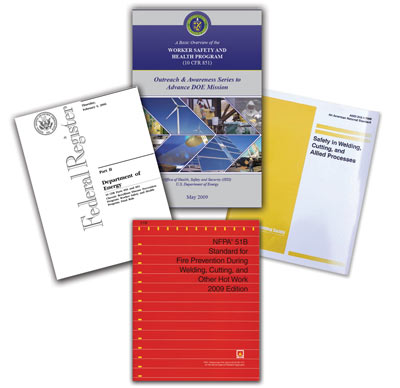-
What Is the Scope of the Standard?
NFPA 51B provides provisions to prevent loss of life and property from fire or explosion as a result of hot work.
-
What other organizations now look to NFPA 51B as the recognized standard for hot work practices?
NFPA 51B is now the hot works protocol referenced by the following agencies:
- Occupational Safety and Health Administration (OSHA) 29 CFR 1910.252
- Department of Energy (DOE) – 10 CFR 851
- American Petroleum Institute (API) – API 2009
-
What are Some of the Requirements in the 2019 Edition?
“The 2019 edition includes new Fire Prevention Precautions for protecting floors, combustibles, opening or cracks, ducts, walls, with a listed welding curtain, welding blanket, welding pad. ” – Chapter 5 of 2019 Standard
-
How does the Standard Define Welding Blankets, Curtains and Pads?
Welding Blanket — A heat-resistant fabric listed, approved, and designed to be placed in the vicinity of a hot work operation. Intended for use in horizontal applications with light to moderate exposures such as that resulting from chipping, grinding, heat treating, sand blasting and light horizontal welding. Designed to protect machinery and prevent ignition of combustibles such as wood that are located adjacent to the underside of the blanket.
Welding Curtain — A heat-resistant fabric listed, approved, and designed to be placed in the vicinity of a hot work operation. Intended for use in vertical applications with light to moderate exposures such as that resulting from chipping, grinding, heat treating, sand blasting, and light horizontal welding. Designed to prevent sparks from escaping a confined area.
Welding Pad — A heat-resistant fabric listed, approved, and designed to be placed directly under a hot work operation such as welding or cutting. Intended for use in horizontal applications with severe exposures such as that resulting from molten substances or heavy horizontal welding. Designed to prevent the ignition of combustibles that are located adjacent to the underside of the pad.
-
What does the Standard Say about Contractors’ Responsibility for Hot Work?
“Management shall be responsible for the safe operations of hot work activity.” – Page Chapter 4, page 6 of 2019 Standard
-
What are Some of the Conditions that Require “Listed or Approved” Materials Before a Hot Work Permit is Issued?
“All combustibles shall be relocated at least 35 ft (11 m) in all directions from the work site, and the following criteria also shall be met:If relocation is impractical, combustibles shall be protected by a listed or approved welding curtain, welding blanket, welding pad, or equivalent.
To prevent the entrance of sparks, the edges of covers at the floor shall be tight, including at the point at which several covers overlap where a large pile is being protected.“ – Page 7 of 2019 Standard
”If hot work is done near walls, partitions, ceilings or roofs of combustible construction, they shall be protected by a listed or approved welding curtain, welding blanket, welding pad, or equivalent.” – Page 7 of 2019 Standard
-
What is the Requirement for Listed or Approved Materials on a Hot Work Permit?
The Standard includes a sample Hot Work Permit that includes “requirements within 35 ft (11m) of hot work.” One of the requirements is:
- Other combustible storage material removed or covered with listed or approved materials (welding pads, blankets, or curtains; fire-resistive tarpaulins), metal shield, or noncombustible materials.
-
Why is using Certified Fabrics Important?
In order for welding blankets, curtains, and pads to meet ANSI/FM 4950 they must undergo and pass stringent third party testing, certification and ongoing audit procedures, and meet the conditions for safety, performance and quality. In addition, manufacturers must maintain a quality control program and submit to manufacturing facility inspections as part of the Approval process.
Update:

Information For Entities Working Under U.S. Dept. of Energy or National Nuclear Security Administration Regulation 10 CFR 851:
The program requires compliance to the latest edition of all pertinent safety standards. For hot work activities, two standards apply:
- ANSI Z49.1 “Safety in Welding, Cutting and Allied Processes”, section 4.3 and E4.3 (1999). These sections deal with Protective Clothing and PPE.
- NFPA 51B “Standard for Fire Prevention During Welding, Cutting and Hot Work”, 2009 Edition. This standard covers provisions to prevent loss of life and property from fire or explosion as a
result of hot work, including welding curtains, blankets and pads, as explained on front.
Auburn Manufacturing Inc. (AMI) is the safest choice and most reliable source for Approved fabrics that meet NFPA 51B for several reasons:
- We were the first manufacturer to achieve FM Approved status of hot work fabrics, and have maintained Approval status since 2004, including annual audits and inspections.
- AMI is a U.S. manufacturer and uses domestically sourced materials. We are able to certify to the requirements of the Berry Amendment, often requested in government-funded projects. We are currently under contract with DoD to supply welding fabrics to U.S. Naval Shipyards.
- AMI fabrics exceed FM Approved requirements with continuous printing of “FM Approved” and the Performance Rating (Curtain, Blanket or Pad) throughout the rolls for easy ID on the job. This addition was driven by a DOE request.
- AMI is a small, woman-owned business, and is certified as such by WBENC.